
S2:E1
Slavs, Sarmatians, and Varangians, Oh My!
Who Were the Rus’?
Timeline of Sources
image: Roman bust of Herodotus, 2nd c. AD (public domain via Wikimedia Commons)
5th c. BC
Herodotus lived in Halicarnassus (modern-day Turkey). He wrote in Greek about the history of conflict, merging military history with ethnography. His account of the Scythians is one of our best early sources for the history of north-eastern Europe.
Herodotus
image: manuscript of Herodotus’ work from the Oxyrynchus papyri (public domain via Wikimedia Commons)
2nd c. AD
Tacitus
image: statue of Tacitus, Austrian Parliament Building, Vienna (public domain via Wikimedia Commons)
Tacitus, a historian writing in Rome, mentions a group of people called the Venethi, who lived in the region of modern-day Poland. Tacitus’ Latin works provide many of the ethnographic names used and referenced by later writers.
image: 11th c AD manuscript of Tacitus’ Annales (public domain via Wikimedia Commons)
6th c. AD
Procopius of Caesarea was a historian and war correspondent who traveled with Belisarius, the general in charge of Justinian’s forces. Although a valuable source for the history of the Slavs, Procopius takes liberties with names and ethnographic details, preferring reference to Herodotus over historical accuracy.
Procopius
image: Procopius’ work, The Secret History, translated by Peter Sarris & G.A. Williamson (https://www.goodreads.com/book/show/561444.The_Secret_History )
6th c. AD
Jordanes worked as a notarius, or secretary, for the magister militum of the Ostragoths. He wrote several historical works and mentions a people called the Sclaveni, commonly identified with the Slavs, living in the area of Dacia (modern-day Romania).
Jordanes
image: manuscript of Jordanes’ Getica (https://alchetron.com/Jordanes#jordanes-4a62fa9c-0eec-43bd-b2ba-14818dddd36-resize-750.jpeg )
7th c. AD
Annales Bertiniani
image: manuscript of the Annales Bertiniani (public domain via Wikimedia Commons)
The anonymous Annales Bertiniani are a collection of manuscripts discovered in France which tell the story of the Carolingians, including their conflicts with the Vikings. This document is the first to reference a people called the Rhos, likely the people we know as the Kievan Rus’.
image: Charlemagne crowns his son, Louis the Pious, whose court likely produced the Annales Bertiniani (public domain via Wikimedia Commons)








